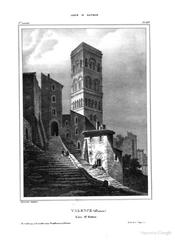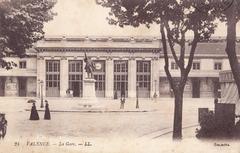Temple Saint-Ruf: Visiting Hours, Tickets, and Historical Sites in Valence, France
Date: 04/07/2025
Introduction
Located in the heart of Valence, France, the Temple Saint-Ruf stands as a testament to the city’s rich religious heritage, distinctive architecture, and vibrant cultural life. With roots stretching back to the medieval period through the influential Order of Saint Ruf, the temple has journeyed through tumultuous epochs—from its origins as a Catholic abbey church, to its destruction during the Wars of Religion, secularization in the French Revolution, and, ultimately, its present role as a Protestant place of worship. Its architecture is a harmonious blend of Romanesque solidity and Baroque artistry, making it both a spiritual haven and a living museum of Valence’s layered history (Petit Futé; Valence Romans Tourisme).
Primarily open to the public during the summer months and for special heritage events, the temple welcomes visitors free of charge, with accessible facilities. Whether you’re interested in its rich past, architectural details like its classical façade and the monument to General Jean-Étienne Championnet, or its ongoing role as a religious and cultural hub, Temple Saint-Ruf offers a compelling experience. Its proximity to other landmarks—including Valence Cathedral and the Maison des Têtes—further enriches any visit.
The following guide details everything you need to know about visiting Temple Saint-Ruf: opening times, ticketing, accessibility, guided tours, its historical evolution, architectural highlights, and practical travel tips.
Table of Contents
- Origins and Early History
- Destruction and Relocation During the Wars of Religion
- Transformation in the French Revolution
- Architectural Features and Heritage
- Visiting Hours, Tickets, and Accessibility
- Guided Tours and Special Events
- Nearby Attractions and Travel Tips
- Community Significance and Contemporary Role
- Symbolic Value and Civic Engagement
- Rituals, Festivals, and Living Traditions
- Educational and Interpretive Initiatives
- Frequently Asked Questions (FAQ)
- Plan Your Visit and Stay Connected
- Sources and Further Reading
Origins and Early History
Temple Saint-Ruf’s story begins in the medieval period, rooted in the legacy of Saint Ruf, an early Christian figure whose spiritual influence led to the foundation of the Order of Saint Ruf. Initially established in Avignon, the order moved to Valence, founding a grand abbey outside the city walls. This abbey became a focal point for religious life and scholarship, contributing significantly to Valence’s cultural and spiritual development (Petit Futé).
Destruction and Relocation During the Wars of Religion
In the 16th century, the French Wars of Religion brought destruction to the original abbey at the hands of Protestant troops, reflecting the broader religious upheavals of the era. Survivors from the Order of Saint Ruf relocated within the city, establishing a new church that would eventually become the present Temple Saint-Ruf (Petit Futé).
Transformation in the French Revolution
During the French Revolution, the church was repurposed for secular uses, serving first as a grain store and then as a venue for revolutionary assemblies. This period marked a significant shift from religious to civic authority, mirroring national trends in France (Petit Futé).
19th Century: Protestant Rebirth
Under Napoleon, the former Catholic church was assigned to Valence’s Protestant community, making it the city’s first Protestant temple. This transition reflects the era’s move toward greater religious tolerance and diversity (Petit Futé).
Architectural Features and Heritage
Exterior
Facing Rue Saint-James, the temple’s classical façade is defined by two prominent pilasters, a central round-arched portal, and a simple triangular pediment. Above, a cornice separates the lower section from two arched windows and a central oculus, illuminating the vestibule and nave. An epitaph on the north wall commemorates Arnaudus Bonum Vinum, a canon of Saint-Ruf (cartepatrimoine.ladrome.fr; fr.wikipedia.org).
Materials and Construction
The temple is built from local Drôme stone, with Romanesque massing and classical decorative details that distinguish it from more ornate neighboring churches.
Interior
Inside, the single, barrel-vaulted nave features five bays, double arches on pilasters, and a chancel culminating in a semi-circular apse. The interior is adorned with 18th-century stucco, floral garlands, trompe-l’œil cornices, and gilded motifs. Above the altar, a sunburst “gloire” with a central triangle symbolizes divine presence (museeprotestant.org).
Monument to General Championnet
A funerary pyramid in the apse honors General Jean-Étienne Championnet, a Revolutionary hero, underscoring the temple’s civic and historical significance (fr.wikipedia.org; navaway.fr).
Organ and Musical Heritage
The organ, installed in 1896 by Joseph Merklin and expanded in the 1970s, is a focal point for musical performances and religious ceremonies (fr.wikipedia.org).
Romanesque and Baroque Synthesis
The building’s robust Romanesque structure coexists with later Baroque ornamentation, reflecting centuries of architectural adaptation.
Visiting Hours, Tickets, and Accessibility
- Regular Openings (2025): June 10 to September 16, every Tuesday from 16:00 to 19:00. Admission is free; no tickets are required (Drôme c’est ma nature).
- European Heritage Days: September 20 and 21, 2025, with extended hours and special events.
- Accessibility: Wheelchair access is available at the main entrance, and most interior spaces are accessible. Some areas, such as the organ gallery, may have limited access due to historic constraints.
- Guided Tours: Available during European Heritage Days and by arrangement through the official congregation website.
Check Valence Romans Tourisme for the latest updates.
Guided Tours and Special Events
Guided tours offer deeper insight into the temple’s history and architecture. The temple also hosts concerts, lectures, and community events, particularly during heritage festivals.
Nearby Attractions and Travel Tips
Combine your visit to Temple Saint-Ruf with nearby sites:
- Valence Cathedral
- Maison des Têtes
- Museum of Valence
Located at 2 rue St James, the temple is easily reached on foot from the city center and the train station. Public transport and parking are nearby.
Community Significance and Contemporary Role
Temple Saint-Ruf is home to the Église Protestante Unie de France congregation, hosting regular worship, community gatherings, and cultural events. Its open-door policy during special events and heritage days fosters inclusivity and dialogue (valence2rives.epudf.org).
Symbolic Value and Civic Engagement
The temple embodies Valence’s history of religious coexistence, secular transformation, and civic engagement. Its layered identity—Catholic, Protestant, and secular—reflects the city’s evolving social fabric (Le Dauphiné).
Rituals, Festivals, and Living Traditions
The temple hosts major Protestant festivals and community events, as well as activities during Heritage Days, drawing visitors and locals alike (JDS Valence).
Educational and Interpretive Initiatives
Guided tours, informational materials, and educational programs explore themes such as religious tolerance, the Reformation, and the role of faith in urban life. These initiatives foster appreciation for Valence’s religious and civic history.
Frequently Asked Questions (FAQ)
Q: What are the Temple Saint-Ruf visiting hours?
A: June 10–September 16, 2025, every Tuesday, 16:00–19:00; extended hours during European Heritage Days.
Q: Is there an entrance fee?
A: No, admission is free.
Q: Are guided tours available?
A: Yes, during Heritage Days and by arrangement.
Q: Is the temple accessible for wheelchair users?
A: Most areas are accessible; some historic features may limit access.
Q: Can visitors attend religious services?
A: Yes, visitors are welcome at services and events.
Q: Are photographs allowed?
A: Generally yes, but please be discreet and respectful.
Plan Your Visit and Stay Connected
Before visiting, check the latest information on opening hours and events on the official congregation website or Valence tourism portal. For guided audio tours and cultural updates, download the Audiala app and follow Temple Saint-Ruf on social media.
Conclusion
Temple Saint-Ruf is a living monument—an architectural and spiritual landmark at the heart of Valence. Its storied past, vibrant present, and open, welcoming spirit make it an essential stop for anyone interested in the history, culture, and community of the Drôme region. Plan your visit during open hours or special events to experience the temple’s beauty and history firsthand.
Explore more:
- [Valence Cathedral: A Gothic Masterpiece in the City Center]
- [Exploring the Drôme Region’s Religious Heritage]
- [Top 10 Historical Sites to Visit in Valence]
Sources and Further Reading
- Petit Futé
- Valence Romans Tourisme
- Le Dauphiné
- Drôme Tourisme
- cartepatrimoine.ladrome.fr
- fr.wikipedia.org
- museeprotestant.org
- navaway.fr
- valence2rives.epudf.org
- JDS Valence

